Emotet Malware Analysis
Overview
Emotet is a trojan primarly used in phishing attacks. It spreads mainly through email containing links or malicious attachments which acts as an initial vector into the victim machine. While emerging in 2014 as a simple trojan with worm like capabilities, the malware has seen a resurgence in the past year and is most likely being used as a dropper or downloader for other malwares.
Contents
- Checking malware sandbox
- Resolving API address dynamically
- Acquiring data and encryption
- Encryption operations
- Communication with C2 server
- Indicators of compromise
- MITRE ATTACK TTPs
Checking Malware Sandbox

On Virus Total most vendors detect the file as malicious.
Resolving API Addresses Dynamically
The malware uses hashes for both DLL names and API names to be used.
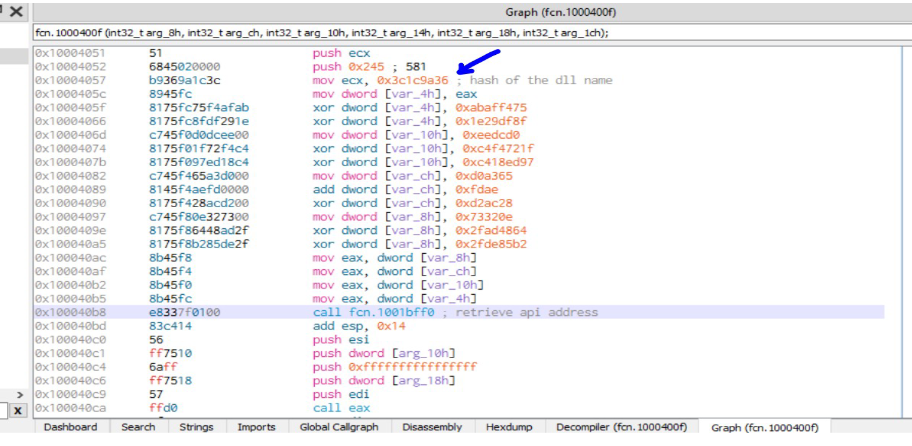
First the matching DLL is found. THe below diagram shows the DLL name retrieval process.
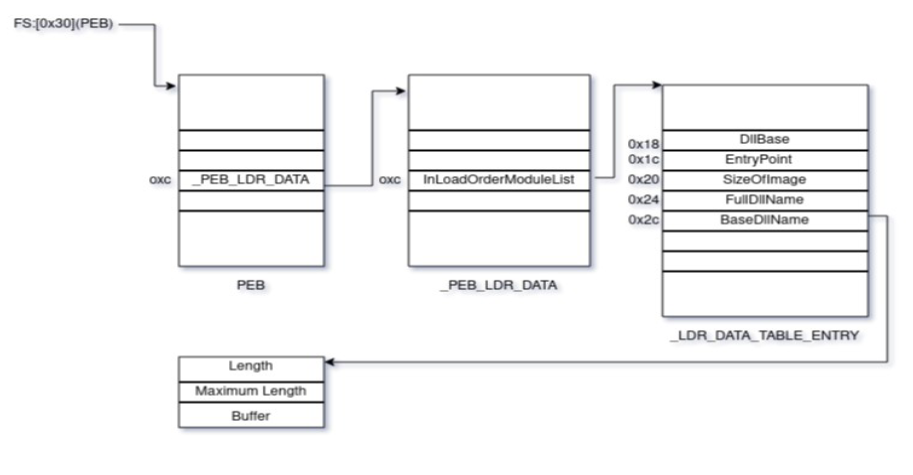
The malware iterates through LDR_DATA_TABLE_ENTRY structures for different DLLs to find the DLL name, calculates a hash of the name and matches the has to the stored hash value. If the calculated hash value matches then the base address of the DLL is retrieved.
The malware then traverses the DLL to the IMAGE_EXPORT_DIRECTORY structure of the PE file which hold the fields AddresOfNames, AddressOfFunctions, AddressOfNameOrdinals.
The AddressOfNames is an array of pointers, these pointers point to the names of the APIs. The malware calculates the hash based on the names of the APIs and matches it with the stored hash. If there is a match the corresponding address of the API is retrieved from the AddressOfFunctionsArray.

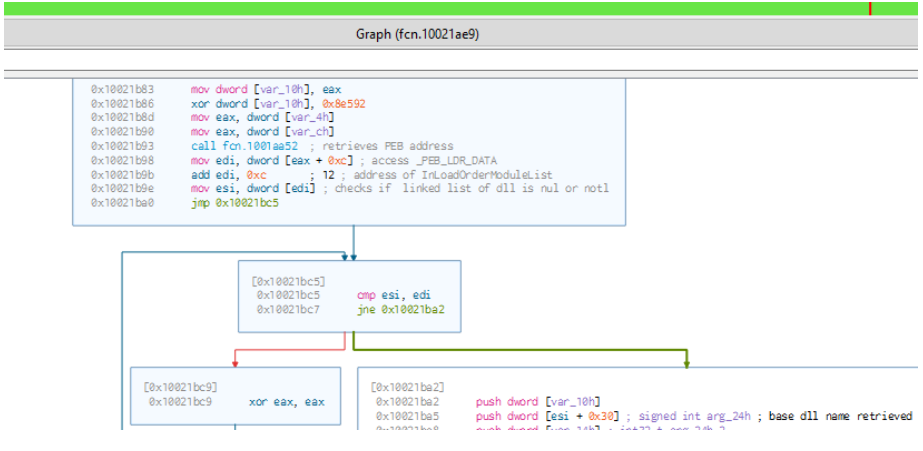
Acquiring Data And Encryption
The malware obtains information using various APIs. It encrypts the data and tries to communicate it over the C2 server. The APIs used from the bcrypt.dll library for cryptographic operations are given below.
| bcrypt.BCryptOpenAlgorithmProvider |
| bcrypt.BCryptCLoseAlgorithmProvider |
| bcrypt.BCryptGenerateKeyPair |
| bcrypt.BCryptFinalizeKeyPair |
| bcrypt.BCryptExportKey |
| bcrypt.BCryptImportKeyPair |
| bcrypt.BCryptSecretAgreement |
| bcrypt.BCryptDeriveKey |
| bcrypt.BCryptImportKey |
| bcrypt.BCryptDestroySecret |
| bcrypt.BCryptDestroyKey |
| bcrypt.BCryptHashData |
| bcrypt.BCryptFinishHash |
| bcrypt.BCryptDestroyHash |
The algorithms used by the malware are:
- Elliptic-curve Diffie-hellman (ECDH): For key generation and shared secret key.
- Advanced Encryption Standard (AES): For encrypting communication with C2 server.
- sha256: For hashing of data to be sent to the C2 server.
Below diagram shows the working of the ECDH algorithm where G represents the generator, d the private keys, Q the Public Keys. The operation ‘X’ represents a scalar multiplication. The public key is an (x,y) point on the elliptic curve.

The report won’t go into the mathematical details of the algorithm but get an idea in relation to the microsoft APIs we need to know how the APIs accomplish the above steps.
Using the BcryptGenerateKeyPair API gives us the Public/Private Key pair. The shared key is than derived using the API cryptSecretAgreement. The BCryptDeriveKey API is used to obtain the final key. The main task is to create a shared secret that is common to both the Server and the infected machine in this case. This shared secret is then used as input to the AES algorithm, which than outputs the final symmetric key that will be used for encrypting messages.
Encryption Operations
BCryptOpenAlgorithmProvider API initializes a CNG(Cryptography API: Next Generation) provider. The algorithm used by emotet malware in this case is ECDH_P256 which is Elliptic-curve Diffie-hellman algorithm.
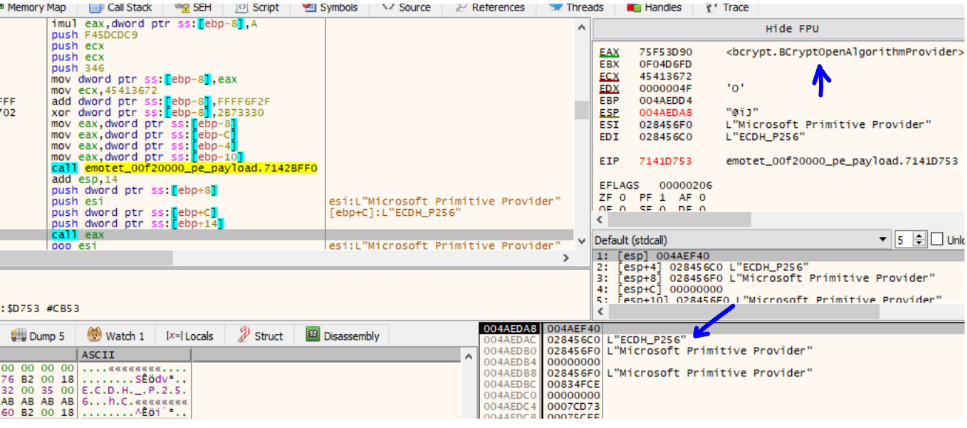
The handle of that is than passed to the BCryptGenerateKeyPair which creates a public/private key pair. BCryptFinalizeKeyPair API finalizes the key pair generated by BcryptGenerateKeyPair.

BCryptExportKey API is then used to export the Public key from the key pair to a BCrypt_ECCPUBLIC_BLOB structure. This public key can now be sent to the malicious server.
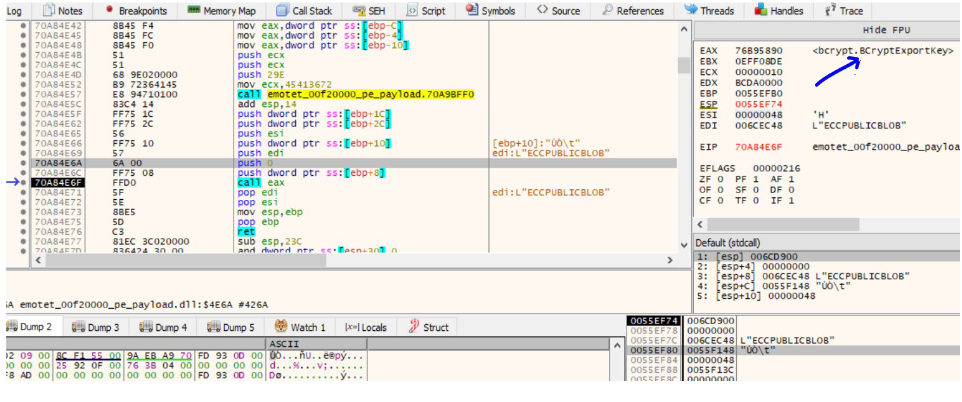
Exported Public Key inside the structure can be seen in the image below.
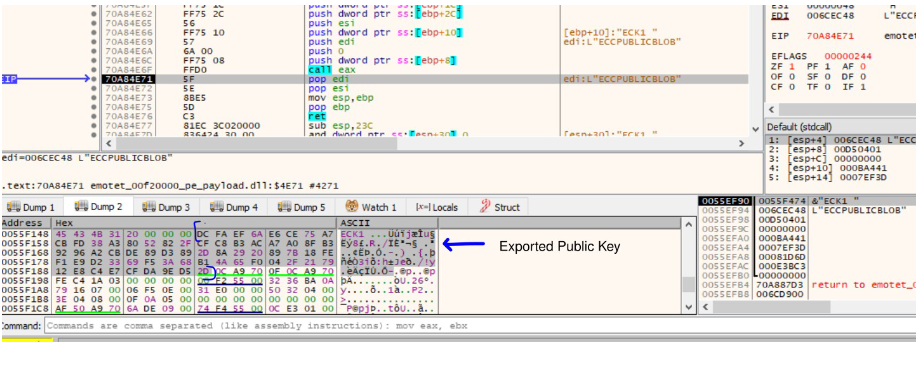
The Public Key of the Server is embedded in the malware inside a BCrypt_ECCPUBLIC_BLOB structure. BcryptImportKeyPair API is used to obtain a handle to it.
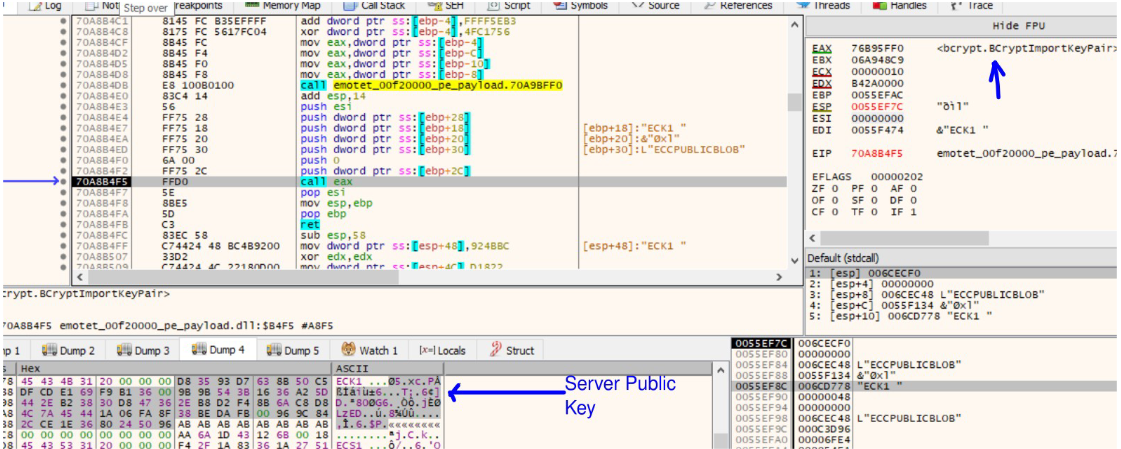
The handle of the public/private key pair obtained using BcryptGenerateKeyPair and the handle of the public key of the Server obtained in the previous step is passed to the BcryptSecretAgreement API. This returns a handle to the shared secret.
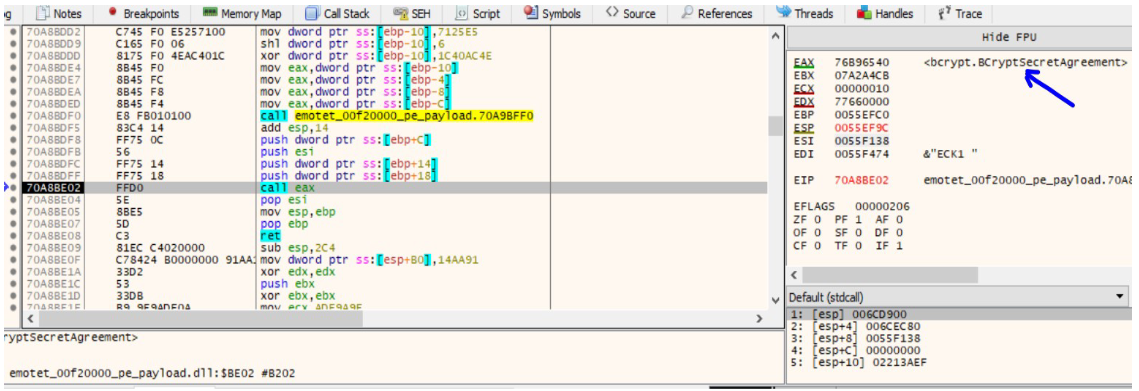
The BCryptOpenAlgorithmProvider is then called to initialize the AES CNG provider. The handle obtained previously of the shared secret is passed to the BCryptDeriveKey API to obtain a final symmetric(same for both malware and server) key of size 32 bytes ie. 256 bit key.
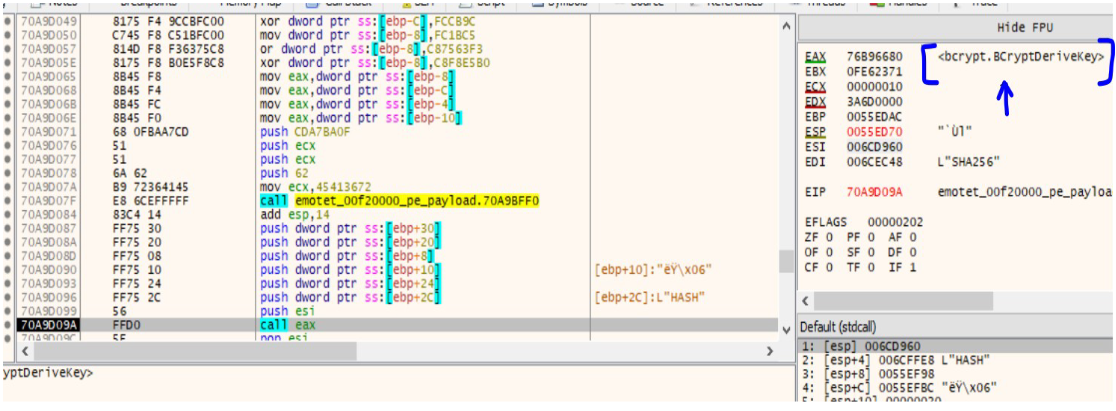
BCryptImportKey is than used to obtain a handle to this key. This key will later be used to encrypt the messages sent to the server. All the other intermediate keys are destroyed using BCryptDestroySecret and BcryptDestroyKey.
Before the Data is to be sent. The hash of the data is calculated, in this case the data is the Computer name obtained using the API GetComputerNameA and the serial number of the C Drive, that is retrieved using the GetVolumeInformation API. Both are concatenated and sent to the server later after encryption.
The BCryptAlgorithmProvider is called to initialize the SHA256 CNG provider. BCryptCreateHash API is called to create a hash object and BCryptHashData API is used to hash the data as seen below.
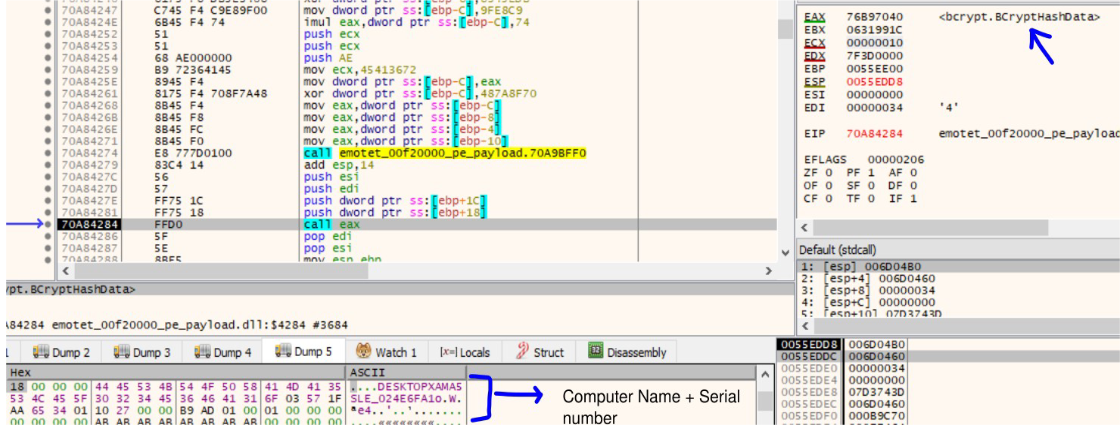
The ComputerName and the hash are then encrypted using the BCryptEncrypt API.

Communication With C2
The data after being converted is prepared to be sent to the server. The sequence of API’s to establish connection to the server are:
| wininet.InternetOpenW |
| wininet.InternetConnectW |
| wininet.HttpOpenRequestW |
| wininet.InternetSetOpitionW |
| wininet.InternetQueryOptionW |
| wininet.HttpSendRequestW |
The malware first uses the InternetOpenW api to get a handle that is later used by other wininet apis.
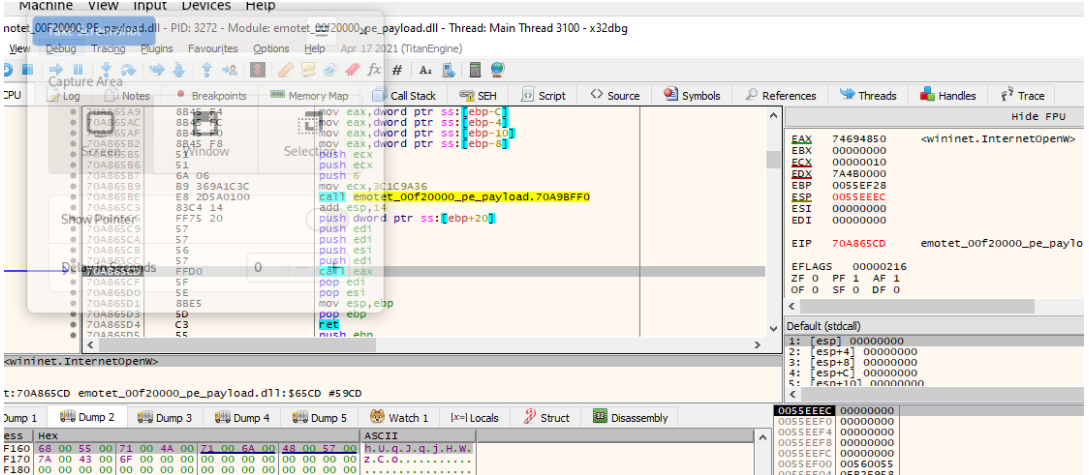
The malware then calls the InternetConnectW api to start a session for the address 186.250.48.5 over port 50.
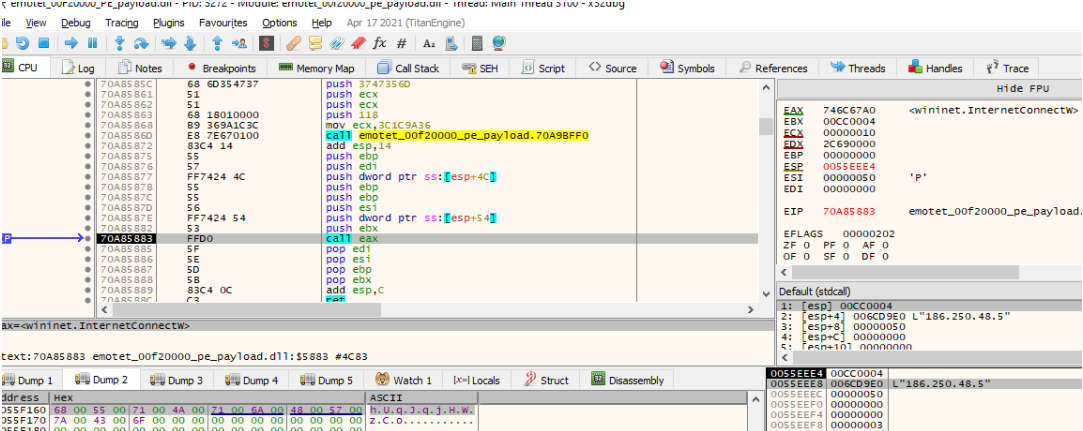
HttpOpenRequestW api is then used to create an Http request handle. The Get method is used in this case and the object name is hugJqjMWzCo. HttpSendRequestW method is used to send the request to the Malicious server. The Http additional header is where the malware stores and sends the data. In this case it is the data previously seen i.e the Public key of the machine + Encrypted Data. Everything is then converted to strings using the API CryptBinaryToStringsW. Which is then appended to the header as the field named Cookie in this case.

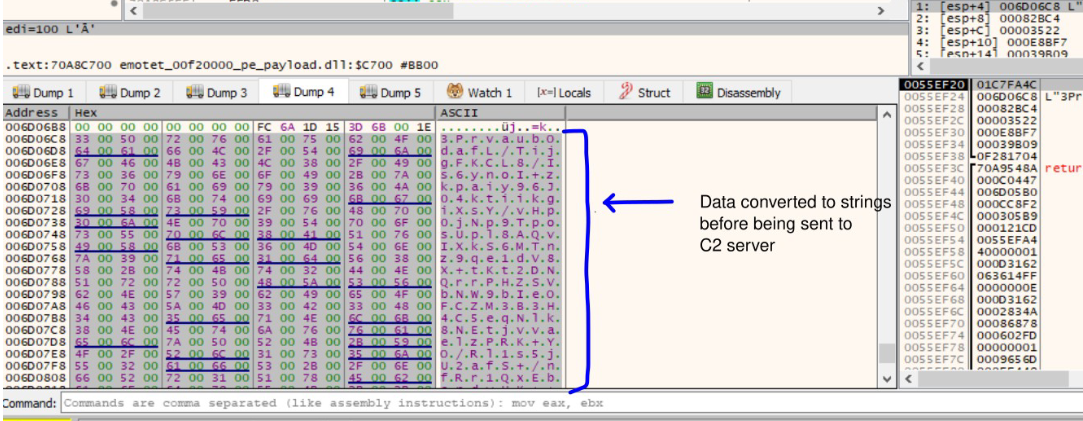

The connection request from the malware to the C2 server can be seen below.
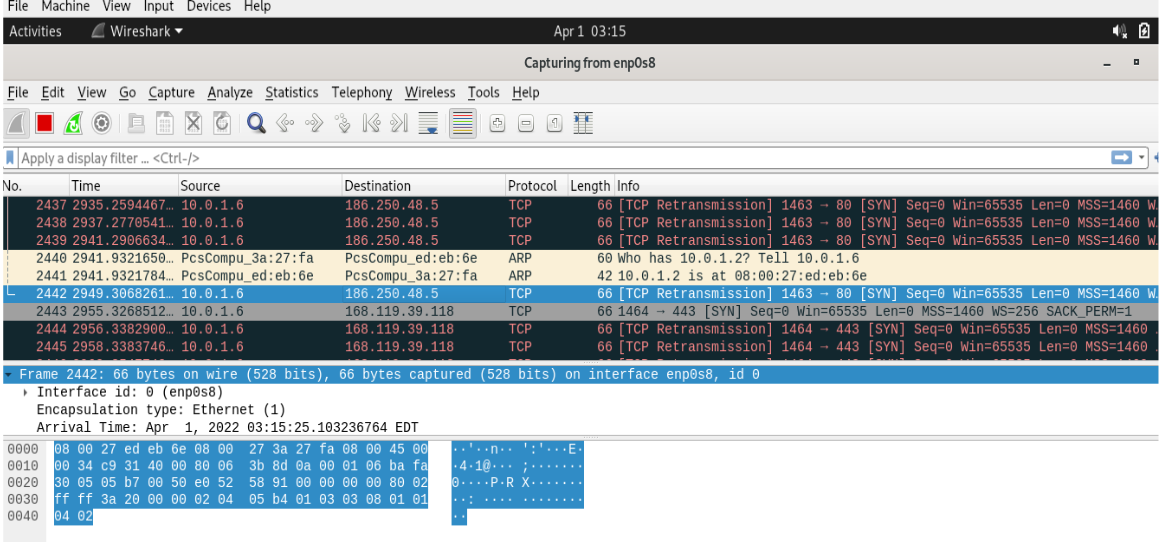
Indicators Of Compromise
| ae5de878deeb48308865377d6a71a769dbf74a06985fa7be19ebdb7a85ed316b | sha256, .exe file |
| 186.250.48.5 | C2 |
| 168.119.39.118 | C2 |
| 185.168.130.138 | C2 |
| 190.90.233.66 | C2 |
| 159.69.237.188 | C2 |
| 54.37.228.122 | C2 |
| 93.104.209.107 | C2 |
| 185.148.168.15 | C2 |
| 198.199.98.78 | C2 |
| 87.106.97.83 | C2 |
| 195.77.239.39 | C2 |
| 37.44.244.177 | C2 |
| 54.38.242.185 | C2 |
| 185.184.25.78 | C2 |
| 116.124.128.206 | C2 |
| 139.196.72.155 | C2 |
| 128.199.192.135 | C2 |
| 103.41.204.169 | C2 |
| 78.47.204.80 | C2 |
| 68.183.93.250 | C2 |
| 194.9.172.107 | C2 |